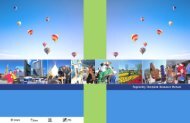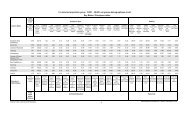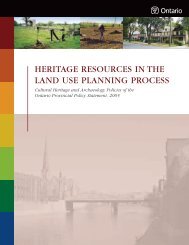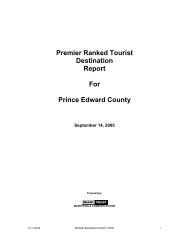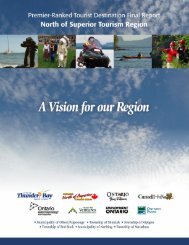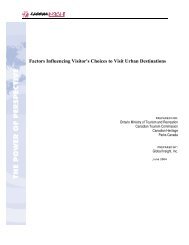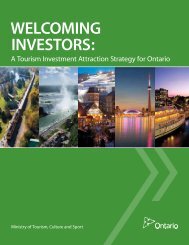Management Guidelines For Forestry and Resource-Based Tourism
Management Guidelines For Forestry and Resource-Based Tourism
Management Guidelines For Forestry and Resource-Based Tourism
- No tags were found...
Create successful ePaper yourself
Turn your PDF publications into a flip-book with our unique Google optimized e-Paper software.
<strong>Management</strong> <strong>Guidelines</strong> for <strong>For</strong>estry <strong>and</strong> <strong>Resource</strong>-<strong>Based</strong> <strong>Tourism</strong> – APPENDIX 3Main Base LodgesDescription: fixed roof accommodation, has a current<strong>Resource</strong>-based <strong>Tourism</strong> Licence <strong>and</strong> commercial l<strong>and</strong>use permit or other form of property tenure. The<strong>Tourism</strong> Act defines a "base of operations" as ‘a licensetourist establishment or an air carrier licensed under thelaws of Canada from which a tourist outfitter maintainsfacilities for communication, transportation <strong>and</strong> the completemaintenance of office records.’Outpost CampDescription: fixed roof accommodation, has a current<strong>Resource</strong>-based <strong>Tourism</strong> Licence <strong>and</strong> commercial l<strong>and</strong>use permit or other form of property tenure. The<strong>Tourism</strong> Act defines an outpost camp as any fixedor portable rental unit that is remote from a base ofoperations <strong>and</strong> accessible only by air, water or foresttrails, <strong>and</strong> is used for commercial purposes.ROADS & TRAILSRecreation Trails• Description: Winter (dog sled trails, cross country trails,snowshoe trails, snowmobile trails, etc.)• Summer (ATV trails, horse trails, portage trails, etc.)• All Season (hiking trails, hunting trails, etc.)Access: Description: road, flight path, water route or rail lineproviding access to a tourism business or associated value. It isrecognized that entire flight paths cannot be addressed; rather,only segments which can be reasonably associated with atourism experience should be considered a value. Usually it isthe final approach portion of a flight path which is a concern.<strong>Tourism</strong> Access Points: Description: l<strong>and</strong>ing, access towater body, access to railroad or other modes of transportationspecifically used to access a tourism establishment.ANCILLARY FEATURESShore Lunch & Picnic SitesDescription: includes shore lunch site, etc.ViewpointDescription: point for viewing prominent scenery or vista, etc.Camping SitesDescription: Type "B" Outpost Camp (i.e. Mini LUP) (e.g.moose camps, bear camps, etc.)Boat CachesDescription: the site where boats are cached according to anMNR permit (applicable in Northwestern Ontario.)Canoe RoutesDescription: route actively marketed for use by guestsof Ministry of <strong>Tourism</strong> licensed resource-basedtourism establishments.Navigable ChannelDescription: Generally a narrow channel connecting twowater bodies used by guests of a tourism establishmentWATER-RELATED FEATURESSwimming BeachDescription: Not a public beach, but, a beach to which guestsfrom a tourism establishment are directed.WILDLIFE-RELATED FEATURESFish <strong>and</strong> Wildlife Viewing SiteDescription: that part of the forest that is especiallyimportant for viewing of wildlife including mooseviewing area, bird feeder area, deer viewing area.Wildlife Hunting StationsDescription: duck blinds, bear baiting areas,deer st<strong>and</strong>s etc.CULTURAL/HERITAGE-RELATEDFEATURESCultural Heritage sitesDescription: An old building, mine archaeological site,interpretive site, historical site or other cultural featurewhich because of its use by a tourist establishmentrequires more protection than that afforded by the"Cultural Heritage <strong>Guidelines</strong>."37



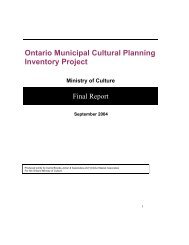
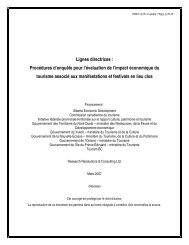
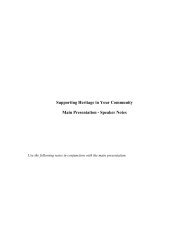
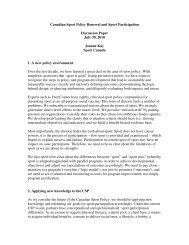
![THIS AGREEMENT made this [date], between [name of owner] (the ...](https://img.yumpu.com/49827605/1/158x260/this-agreement-made-this-date-between-name-of-owner-the-.jpg?quality=85)
